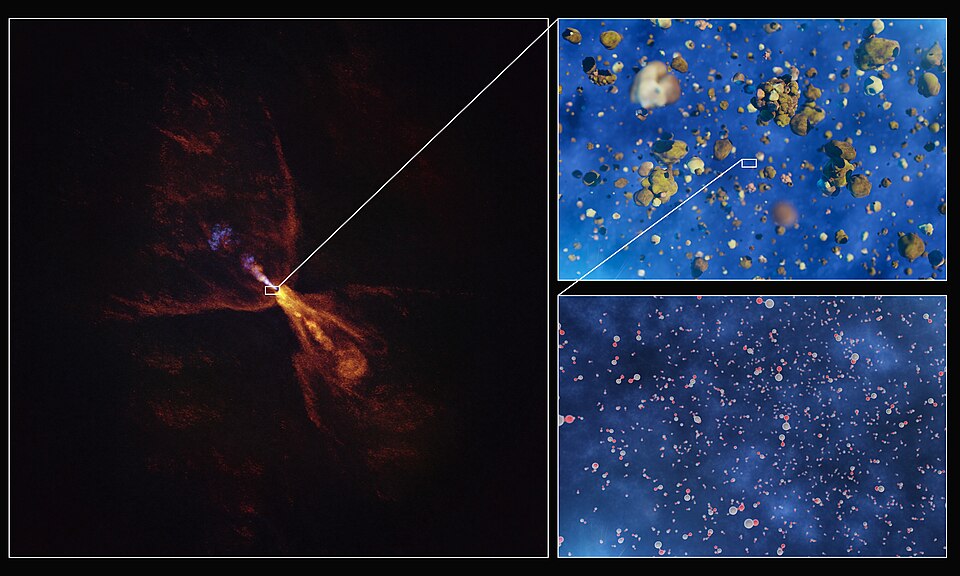Astronomers Capture Early Stages of Planet Formation Around HOPS-315

In a groundbreaking discovery, astronomers have observed the initial stages of planet formation around a young star known as HOPS-315, located approximately 1,300 light-years from Earth in the Orion molecular cloud complex. Utilizing advanced technologies from the Atacama Large Millimeter/submillimeter Array (ALMA) and the James Webb Space Telescope (JWST), researchers identified rocky mineral particles beginning to coalesce around this protostar, marking a significant milestone in the study of planetary formation.
This observation, detailed in a recent study published in *Nature* by an international team led by Dr. Melissa McClure, a professor at Leiden University, provides valuable insights into how Earth-like planets may form. "For the first time, we have identified the earliest moment when planet formation is initiated around a star other than our Sun," McClure stated, emphasizing the significance of this development in understanding the origins of our own solar system.
The process begins with a massive cloud of gas and dust collapsing under its own gravity, leading to the formation of a protostar like HOPS-315. This protostar retains leftover materials that flatten into a rotating protoplanetary disc, which is critical for the birth of new planets. As the disc cools, particles begin to adhere together, forming rocky planetesimals - the building blocks of terrestrial planets.
In HOPS-315, the team detected silicon monoxide (SiO) both as gas and as newly forming crystals. The finding illustrates how the building blocks of planets manifest in the protoplanetary disc. The JWST’s infrared capabilities enabled the team to analyze the chemical composition of the materials surrounding the star, while ALMA was instrumental in mapping the spatial distribution of these compounds.
According to Dr. Logan Francis, a postdoctoral researcher at Leiden University and co-author of the study, the detection of warm SiO alongside silicate minerals indicates temperatures around 1200 Kelvin in the star's midsection, sufficient to vaporize rocks. As these silicates cool, they condense into solid minerals, which are essential for the formation of planets. "This hot mineral is the first feedstock that you have to start growing things in the disk," McClure explained.
The study also revealed that SiO gas is moving at speeds of up to 10 km/s, while jets of SiO travel ten times faster. This disparity suggests that some SiO gas is cooling and transitioning into solid dust, akin to steam condensing into water. The region exhibiting these chemical signatures is comparable in size to the asteroid belt in our solar system, corroborating the presence of minerals akin to those found in ancient meteorites from our own planetary system.
The Herschel Orion Protostar Survey, which identified HOPS-315 as one of 410 young stellar objects, further contextualizes this discovery. This survey utilized the Spitzer Space Telescope to explore various types of protostars and their evolutionary paths toward forming planetary systems.
Astronomers had previously debated whether rocky planets formed closer to their stars or farther out, where water exists in frozen states. The observations of HOPS-315 suggest that rocky planets can form in the hotter regions nearer to the star, where silicon monoxide is prevalent. McClure noted, "Our results... provide physical constraints on what the region around the sun within 1 AU might have looked like for our solar system, which will allow people to test these theories."
Dr. Merel van’t Hoff, an astronomer at Purdue University and co-author of the study, expressed excitement over the implications of HOPS-315 for understanding our cosmic history. "This system is one of the best that we know to actually probe some of the processes that happened in our solar system," he stated, underscoring the importance of this research in unraveling the mysteries of planetary formation.
The implications of this study extend beyond HOPS-315, as it enhances our understanding of the conditions necessary for planet formation and offers a glimpse into the potential similarities between other solar systems and our own. As astronomers continue to refine their techniques and technologies, the exploration of new stellar systems promises to yield further revelations about the origins of planets and the potential for life beyond Earth.
Advertisement
Tags
Advertisement





